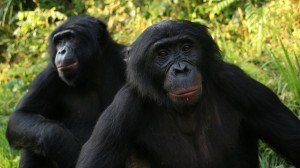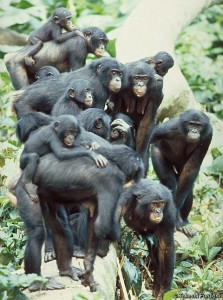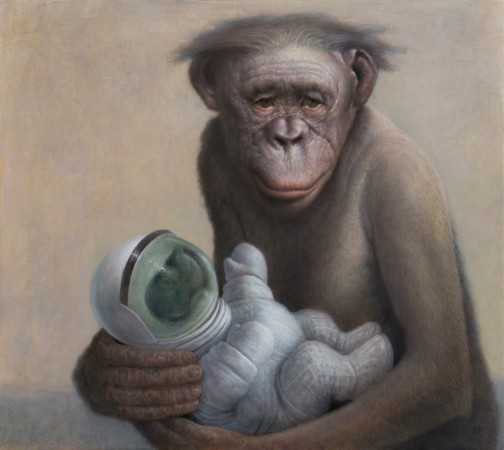David Greig’s THE EVENTS
In 2015 while at the theatre, I twice caught wind of the bonobo. That is to say, two different plays, each from a contemporary playwright, mentioned this pacific chimpanzee-like species that resides in the Democratic Republic of the Congo. Both references seemed intended to shame the audience. We were supposed to feel dismayed, even chastised, by the realization that a rival species, this hippie or left-bank ape, as bonobos are called, is our non-violent moral better. The first bonobo mention was in David Greig’s THE EVENTS (performance on 3/6/15 at New York Theatre Workshop).
THE EVENTS concerns the impetus and aftermath of the 2011 domestic terrorist attacks in Norway by Anders Breivik. The van-bombing of government buildings in Oslo and then the massacre of young people at a youth camp on Utøya Island. All told, 77 people died. Using only a choir and two actors (Neve McIntosh and Clifford Samuel), folding chairs, and no set–THE EVENTS is a minimalist exploration of what might have moved a young man to mass murder. And how a community should respond.
Bonobos play a brief but important part in the story’s narrative. Near the end of THE EVENTS comes the following lesson.
Human beings are a species of ape. For a long time it was thought the apes to which we are most closely related were chimpanzees.
Like early humans, chimps travel in small bands, hunting and gathering. Chimps are territorial. Groups are ruled by dominant males. If a group of chimpanzees encounters another group of chimpanzees in the forest, they will fight each other to establish control of the territory.
Recently, in the Congo, a new species of ape was discovered, bonobos. Bonobos also travel in small bands, hunting and gathering, but bonobos are not violent. Bonobo groups are ruled by senior females. If a group of bonobo encounter another group of bonobos in the forest, they will have sex with each other in order to establish relationships.
What? This bonobo parable didn’t land well in my playwright skull. Wasn’t this just the grander version of namedropping. Species Dropping? The sentiment came off as if from our host at a cocktail party offering a saucy toast to stimulate party chatter. “Ahem, ahem, If only people would simply put down their war toys and do it like bonobos.”
Mostly it didn’t seem fair to them
To label bonobos as hairy angels, our ontological superiors, puts the burden of moral purity on creatures that didn’t ask for this judgment. No matter how flattering. To idealize them as Rousseau’s noble savage or like Adam and Eve before the expulsion from Eden is to set them up for failure in human terms, not their own. Why did I have the lingering suspicion that, in this context, bonobos were being bamboozled? . . .
Well, because they are bound to be more complicated than THE EVENTS suggests. Recently, as pop-primatologists, we have idealized other “relative” species like the savannah baboon, the gorilla, the chimpanzee. We have idealized our relative species only to discover, in time, that they did not serve as instructive models for our idealism.
Preaching Bonobo Love, Are You?
This was a departure of what I knew of the playwright. I’ve read and admired his Dunsinane (a sequel to Macbeth), The Strange Undoing of Prudencia Hart, The Cosmonaut’s Last Message to the Woman He Once Loved in the Former Soviet Union, and The Architect. Born in Edinburgh in 1969 and raised in Nigeria, David Grieg is a globally conscious theatre artist. He has a keen and innovative sense of craft and the temerity to address diverse subjects on a grand scale. In his work I hadn’t experienced anything like this before. I needed a fuller bonobo picture.
After reading up on our species cousin, I learned that, indeed, bonobos are expert conflict resolvers. For more than three decades there is no record of any lethal aggression among bonobos in the wild. Richard Wrangham in Demonic Males puts it like this:
We can think of them as chimpanzees with a threefold path to peace. They have reduced the level of violence in relations between the sexes, in relations between males, and in relations between communities.
But there’s more to the story. The foremost authority on captive bonobos is the primatologist and popular author Frans de Waal whose recent book The Bonobo and the Atheist: In Search of Humanism Among the Primates is a fascinating read. Over the years since the bonobo has vaulted into the popular imagination, de Waal has had to temper the view of a politically correct ape.
That bonobos can be aggressive is not in doubt. We know of fierce group attacks, mostly by females against males. Many such cases have been documented at zoos over the years, and have actually led to changes in how bonobos are kept. Since separation of mothers and sons disrupts a protective bond, zoos are increasingly keeping them together.
From what I’ve been able to glean in my quick study of our closest ape relative, there is so much we still need to learn about (or from) the bonobo. We know very little about bonobos truly in the wild, that is, beyond researcher provisioning. Because of the dense forestry and dangerous political climate and civil war for years in their habitat, the Democratic Republic of the Congo—bonobos have been difficult to observe doing anything but sit in the trees.
Field researcher Gottfried Hohmann may have inspired the bonobo passage in THE EVENTS. Hohmann, a German evolutionary anthropologist, has been visiting the Congo since 1989. About bonobo groups meeting in the tropical forest, Hohmann has said: “It starts out very tense, with shouting and chasing, but then they settle down and there is female-female and male-female sex between members of the two communities. Grooming may occur, but remains tense and nervous.” Hohmann added that groups in the wild don’t always mingle and that males don’t groom each other. For me, a more complex picture of this animal began to emerge.
Events and The Ape Mirror
Years ago I used to drive to the St. Louis Zoo. There on several occasions I was able to make eye contact with orangutans. My experience of this gaze, the ape mirror, left me feeling peaceful and renewed. An animal lover, I have never felt the Victorian bias of our species being morally superior to other species. Nor did I make the assumption that the orangutans were morally superior to me. I felt camaraderie of the spirit, no judgment where one wasn’t invited. We are the same in that we inhabit the earth. In other ways we are just different.
I feel no sense of shame that bonobos might have something to teach human beings about peaceful coexistence. But after experiencing THE EVENTS, I wondered what conflict resolution through sex, observed in another species of ape, had to do with the recent lone gunman mass killings in Norway. The latter involves one group encountering another in the wild and diffusing potential territorial conflict through sex. The former is a heavily armed individual, who took many young lives in order to make larger his political view.
Both “events” involve the territorial. One a localized Congo phenomenon with the adversaries present. The other an abstract conflict that existed in the mind of an extremist Norwegian who substituted innocents for an absentee target. [The homicidal motive Breivik acted on was partly fueled by his Anti-Islamic political agenda, to have all Muslims deported from Europe. ]
Granted as a species we have something to learn about non-violent co-existence, but the circumstances of human beings with billions of us roaming the earth and an endangered and reclusive ape relative of ours in the Congo are quite different. If we were the endangered species and they the incredibly prolific ones, would our roles reverse? Would bonobos celebrate the peaceful traits of those darling humans on surfboards in Southern California?
How could we employ the more peaceful example of the bonobo to the benefit of humankind? What could we learn from the bonobos that we couldn’t better learn from non-violent human communities like the Amish? I remember a show I saw years ago at Rattlestick Playwrights Theatre: Jessica Dickey’s THE AMISH PROJECT (2009) about the forgiveness that the Amish exhibited after the Nickel Mines School shooting. The Amish Project is often revived in theaters nationwide. See it if you have the chance.
For decades of bonobo research, there are no known killings among them. We don’t know how they would respond to “bonobocide.” When Claire, the vicar character in THE EVENTS, doesn’t take vengeance when she could have poisoned the mass killer with mushroom powder in his tea, she may or may not be behaving, forgiving, as bonobos would. We don’t know. But she is taking a step toward the forgiveness that the Nickel Mines Amish demonstrated after their tragic event.
Can observing conflict resolution in bonobos help humankind with our violence problem? As fate would have it, weeks after attending THE EVENTS, I would encounter bonobos a second time in the theatre. This time in THE QUALMS by Bruce Norris, the subject of Bonobo and Drama Part 2!





Leave a Reply